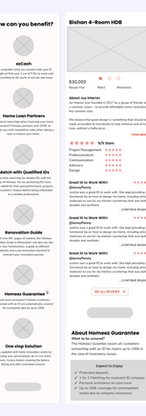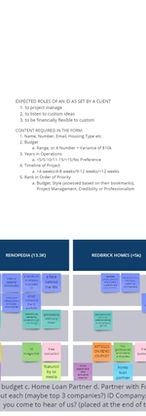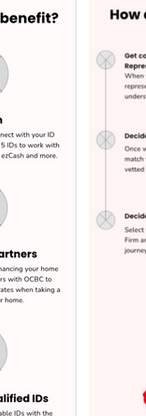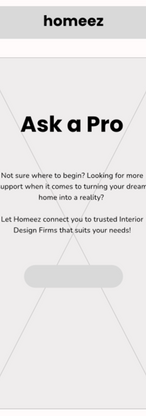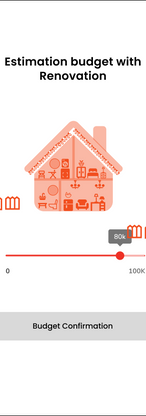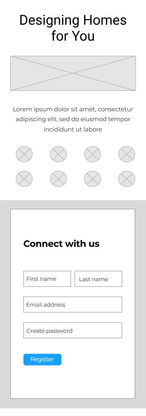
CHALLENGE
"Create a lead generation page that reflect Homeez as the leading renovation company partner"
How might we creatively engage consumers?
How might we revive the joy of home decor in our customers?
ROLE
UX Research & Designer
(Start-up Renovation Technology/ Interior Design/ Real Estate)
Focus Group Discussions (Miro)
Competitor Review (Miro)
Customer Insight & Ideation (Miro)
Low & High Fidelity Designs (Figma)
Context: Revolutionizing Lead Generation
In the realm of user experience design, there comes projects that promises to reshape the foundations of a company's operations. Although miniscule in the spectrum of services offered by many companies, I was tasked to create a lead generation page from scratch .This project was of paramount importance for my company as it had not before, had any research on this customer segment, nor experience at engaging this new revenue stream.
A lead generation page, is a contact point for a business to attain information from new customers in order to engage them in future partnerships. In the case of this company, I was creating a lead generation page for home owners to share with us, information relevant to their ideal home design and match them to an interior designer.
Main Objective:
I was tasked to consolidate baseline research and mockups as foundations for the company's future iterations of this business stream. Over 3 weeks, my design lead and I moved from research to the creation of the first iteration of the product. This included the very created a market research survey, collated qualitative and quantitative research, sourced for and conducted focus group discussions, insight generation, creation of user flows and the design of low-fidelity mockups.
Moving away from project deliverables, my aim for this project was to make sure I answered the following questions. "How might we creatively engage consumers?" and "How might we revive the joy of home decor in our customers?" Jumping the gun a little, I found our from research that most home owners love looking at design ideas for their home, but feel waned along the way, when they spend countless hours in search of "the one" interior designer for them. My job was to design a product that brought them back the joy of home design, while increases the chances of them finding their match.

Snapshot of general UI flow
Impact: Transforming User Lives and Revenue Streams
The was a pivotal moment for the company as it was our first time dabbling with lead generation. The greatest concern for the product was to create a solution that not only met the baseline needs of our users but also set us apart from existing competitors.
When the first iteration was brought up to my directors, they were very pleased and found it paved the way for lead generation very nicely. The chief technical officer decided to keep the gamification aspect of the form for future iterations as he felt it maintained uniqueness in the market, and reflected the company's young culture - something they wanted to keep when creating a personal feel for potential and existing clients.
Role & Team: The Architect of User Understanding
In this multifaceted project, I played a pivotal role as the architect of user understanding. My responsibilities spanned from the inception of the project to its execution. My journey began with collecting user research through in-depth focus group discussions and interviews. These interactions, which involved 8 carefully selected participants, were pivotal in understanding the nuanced needs, pains, and gains of our prospective users.
I transformed these raw interactions into valuable insights that would form the bedrock of our design. The creation of empathy maps, customer journey maps, and user flows became crucial tools in our design arsenal. This meticulous groundwork was imperative in crafting a product that not only served its functional purpose but also resonated with users on a deeper, emotional level.
Method: Designing for User Engagement

Double diamond approach: discover, define, develop & design
With a clear understanding of our users' needs, we set out to design a lead generation page that would not only capture user information for future contacts and contracts but also engage users effectively. In a market where competitors like HomeRenoGuru, Qanvast, and Red Bricks were vying for user attention, our challenge was twofold: functionality and engagement.
Competitor Review: Unveiling the Competitive Landscape
As we ventured into this competitive landscape, the first step was to conduct a comprehensive competitor review. I embarked on a journey to dissect our competitors' offerings, categorizing them into "Must Haves," "Should Haves," and "Could Haves." However, our quest for innovation didn't stop there. We took a step further and introduced a category of our own: "Won't Have."
This bold move allowed us to distance ourselves from the competition, identifying areas where we wouldn't follow the crowd and instead focus on what truly mattered to our users. The image below illustrates the insights derived from this thorough competitor analysis.

Competitor review: Must Have, Should Have, Could Have, Won't Have

Competitor Review: Content Creation
User Flow: Mapping the Journey
The user's journey in the realm of home renovation is a complex web of decisions, from the initial spark of interest in home improvement to the final commitment to an interior designer. To tackle this intricate challenge, I embarked on the task of mapping out the user flow.
Creating multiple user personas, each representing a distinct user journey, was crucial. This required envisioning how users might jump from one service provider to another, evaluating their choices, and ultimately signing on with an interior designer. The creation of these user flows provided invaluable insights into the decision-making process and allowed us to tailor our lead generation page to meet the diverse needs of our users.
As we dove deeper into the design process, it became clear that addressing the multifaceted nature of our users' journeys would be pivotal in creating a lead generation page that not only captured information but also guided users toward their ideal interior designer.
Lesson learned: Designing with Purpose
Understanding the User Decision Matrix
The first lesson I embraced was the incredible power of user-centric design. To navigate this challenge, we dived into the intricate thought process of our users. In the world of homogenous products, customers relied on specific metrics to determine which company to trust and, more importantly, how many to trust. These key factors included reliability, proximity, spread, and time efficiency.
The Magic of Gamification
Compared to traditional lead generation pages designed for function - data collection, We designed ours for engagement. This meant the look and feel of the page was interactive, responsive and used multiples haptics. These include having shorter pages and the use of swipe or drag functions.


Sample of lead generation pages in the industry

Proposed spread of low-fidelity pages
One of the standout features of our lead generation page was the incorporation of gamification—a concept borrowed from dating apps. This engaging element not only made the data collection process more enjoyable but also aligned with our visual appeal for the project. In the interior design space, where 3D mock-ups and images of ideal homes are commonplace, visuals are more universally understood than text descriptors, which can vary with modern tastes.
The engaging element to our data collection process. It not only made the experience more enjoyable for users but also added a layer of interactivity that set us apart from traditional form-style data collection methods. The positive response from the company's director reaffirmed that innovative approaches like gamification can make a world of difference in user engagement.
Operationally, these pictures which were swiped on, were also then sent to the interior designers they were matched with. Collecting not only their personal information, but also curating a "mood board" for them to work with.

Snapshot of swiping feature
Challenges: Creativity Amidst Constraints
Components; Reduce, Reuse, & Recreate?
However, the path to innovation was not without its challenges. Building a lead generation page from scratch meant that many components were non-existent before the project's inception. This called for creative thinking and resourcefulness in incorporating pre-existing elements into the new user interface.
With no pre-existing components to work with, I had to think creatively about how to incorporate necessary elements into the design. This was a time-consuming process that required resourcefulness and a keen eye for design consistencies.
For instance, the decision of which component to be used for the tracker under a carousel of images. Would it be wise to use a progress tracker, which was previously used to track the progress of the form, for a carousel? No! While the designs are similar in tracking upcoming pages, the use case is different. The use of a progress bar psychologically served to track customer's progress and encourage task completion - goal visualization. Whereas the ellipses used for the carousel is intended to denote additional images which can be screened through.
While the aesthetic vision may be similar, the use case is different, and I had to adopt components which were not were aesthetically pleasing, appropriate and functional.

Snapshot of component types
Balancing Complexity
Another challenge was balancing the complexity of the user journey. In the realm of home renovation, the decision-making process is multifaceted, with users considering various options before committing to an interior designer. Creating user flows that catered to these diverse journeys was no small feat. It required careful planning and the creation of multiple user personas to ensure we addressed the needs of all potential users effectively.
Interdisciplinary Experiences: A Holistic Approach
Critques from Designers
Participating in design critiques with fellow designers allowed for constructive feedback and the refinement of our ideas. It emphasized the importance of peer review in the design process.
Product Pitching
Pitching a design of a product based on a dating app seemed rather intense for me. Thinking that a business which dealth with such ilfe changing decisions regarding a home made me unnerved to pitch a deign idea. Thankfully, I was supported by colleagues who welcomed ideas, even i i meant they failed in the early stages. I grew to embrace a culture of curiosity and creatiity, even if it ay sound too out-of-thebox.
Future Improvments
In retrospect, this project was not just about designing a lead generation page; but about laying the foundation for future research and design endeavors. The project received resounding approval from the company's director, who recognized the value of gamification in making the data collection process engaging and enjoyable.
Under longer timelines, it would have been nice to have worked on improving the product's future interactions with the consumers. One avenue to explore would be providing pages for action "post-connection". Whether this meant pages were introduced for clients to feedback their experience, review their submission or track the progress of their inquiry, there is much to be designed after homeowners and interior designers have been connected.


Snapshot of Possible Second Iteration Additions


